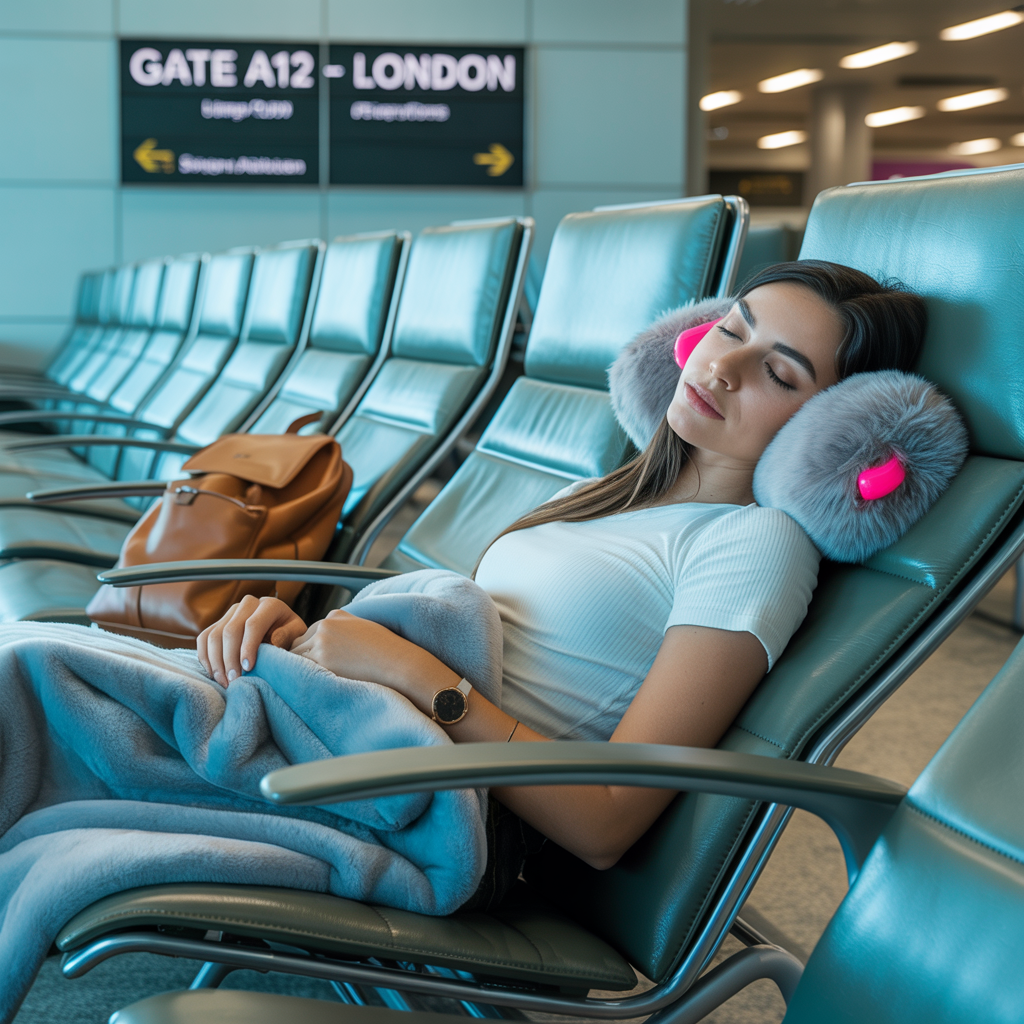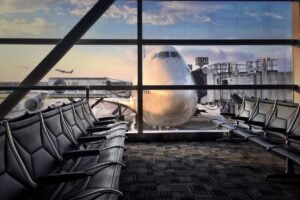Sleeping in Airports: Why It Happens, How to Avoid It, Top Hubs and Digital Nomad Hacks
Traveling the world is an exhilarating experience, but it often comes with unexpected challenges—like finding yourself stranded in an airport overnight. Sleeping in airports has become a reality for many travelers, whether by choice or necessity. From budget-conscious backpackers to digital nomads chasing flexible schedules, the airport terminal can transform into a makeshift bedroom for a night. In this comprehensive guide, we’ll explore why people sleep in airports, how to avoid it, the best airports for overnight stays, average costs, free options, credit card benefits, and a special hook for digital nomads who live on the move.
Stranded or Strategic? The Reasons Behind Airport Sleepovers
Sleeping in airports is more common than you might think, and it happens for a variety of reasons:
- Flight Delays and Cancellations: Weather disruptions, mechanical issues, or airline overbooking can leave travelers stranded. For example, snowstorms in Europe or hurricanes in the U.S. often lead to canceled flights, forcing passengers to spend the night in the terminal.
- Long Layovers: Budget travelers often book cheaper flights with extended layovers to save money. These layovers, sometimes lasting 8–12 hours or more, can occur overnight, making a hotel stay impractical or too costly.
- Early Morning or Late-Night Flights: Low-cost carriers frequently schedule flights at odd hours, such as 6 a.m. departures or midnight arrivals. Arriving at the airport the night before or staying after a late flight can lead to an overnight stay.
- Budget Constraints: For backpackers, students, or digital nomads, skipping a hotel to save money is a common strategy. Sleeping in an airport can stretch a travel budget, allowing funds to be allocated to experiences rather than accommodation.
- Visa Restrictions: International travelers may face visa issues that prevent them from leaving the airport during a layover, leaving them no choice but to stay in the terminal.
- Missed Connections: Mistimed flights or tight connections can result in missed flights, leaving passengers stuck until the next available departure.
For digital nomads, who often prioritize flexibility and cost-efficiency, sleeping in airports can be a strategic choice to maintain their location-independent lifestyle. However, it’s not always a pleasant experience, and understanding how to navigate or avoid it is key.
Escape the Terminal: Tips to Skip Overnight Stays
While sleeping in an airport might be unavoidable in some cases, there are strategies to minimize the chances:
- Plan Flight Schedules Carefully: Avoid booking flights with excessively long layovers or early morning departures unless you’re prepared to spend the night. Use tools like Google Flights or Skyscanner to find better connections.
- Choose 24/7 Airports: Opt for major international hubs that operate around the clock, such as Dubai (DXB), Singapore Changi (SIN), or Istanbul (IST). These airports often have better amenities for overnight stays.
- Book Airport Hotels or Nearby Stays: Many airports have on-site or nearby hotels. For example, the TWA Hotel at JFK or the Grand Hyatt at SFO offer convenient options. Booking through platforms like ParkSleepFly can bundle parking and hotel stays for added savings.
- Use Travel Insurance: Comprehensive travel insurance, such as World Nomads or SafetyWing, can cover hotel costs for delays or cancellations. Some credit cards also offer trip interruption benefits, reimbursing expenses for unexpected overnight stays.
- Leverage Airline Policies: If a delay or cancellation is the airline’s fault, they may provide hotel vouchers or lounge access. In the EU, airlines are required to offer accommodation for involuntary bumps. Always ask the airline for assistance.
- Explore the City: If visa requirements allow, use long layovers to explore nearby cities. Websites like SleepinginAirports.com provide guides on how to leave the airport and what to do nearby.
- Work Remotely Instead: For digital nomads, turning an airport layover into a productive work session at a café or lounge can keep you awake and avoid the need to sleep.
By planning ahead, you can often sidestep the need to sleep in an airport, but if it’s unavoidable, choosing the right airport and preparing properly can make all the difference.
Sleep-Friendly Skies: Top Airports for a Restful Layover
Not all airports are created equal when it comes to sleeping. Some are designed with traveler comfort in mind, offering dedicated rest zones, sleeping pods, or 24-hour lounges. Based on reviews from SleepinginAirports.com and other travel sources, here are some of the best airports for overnight stays:
- Singapore Changi Airport (SIN):
- Why It’s Great: Known for its traveler-friendly amenities, Changi offers free rest zones with reclining chairs, nap pods, and even a 24-hour movie theater. The airport has showers, Wi-Fi, and 24-hour food options.
- Tips: Head to the Snooze Lounges in Terminals 1, 2, or 3 for padded seating without armrests.
- Seoul Incheon International Airport (ICN):
- Why It’s Great: Incheon provides designated rest zones with free padded lounges and beds. The airport is clean, quiet, and has 24-hour amenities like showers and restaurants.
- Tips: Look for the Nap Zones in the main terminal or near Gate 43.
- Tokyo Narita International Airport (NRT):
- Why It’s Great: Narita features overnight rest areas with padded benches and footrests. It’s known for its cleanliness and helpful staff.
- Tips: Check out the rest areas in Terminal 2 for armrest-free seating.
- Amsterdam Schiphol Airport (AMS):
- Why It’s Great: Schiphol offers nap rooms, quiet zones, and reclining lounge chairs. The airport also has YotelAir cabins for hourly rentals.
- Tips: Visit the Library Lounge for a quiet nap or book a sleep pod in advance.
- San Francisco International Airport (SFO):
- Why It’s Great: SFO has a designated “quiet zone” and a 24-hour Yoga Room. The Berman Reflection Room in the International Terminal is ideal for rest.
- Tips: Avoid armrest-heavy benches and head to longer benches in the International Terminal.
- Dallas/Fort Worth International Airport (DFW):
- Why It’s Great: DFW offers couches, padded chairs, and roll-out cots during bad weather. The Club at DFW lounge is accessible for a day-pass fee.
- Tips: Look for leather chairs near Gate D27 or the children’s play area at Gate D10.
These airports stand out for their comfort, security, and amenities, making them ideal for overnight stays. Always check SleepinginAirports.com for specific terminal tips and traveler reviews before your trip.

The Price of Rest: What It Costs to Sleep in Airports
Sleeping in an airport isn’t always free, especially if you opt for premium amenities. Here’s a breakdown of potential costs:
- Sleeping Pods or Capsules:
- Cost: $10–$40 per hour, depending on the airport and pod type (e.g., GoSleep, YotelAir, or Minute Suites).
- Examples: At Amsterdam Schiphol, YotelAir cabins cost around $20–$30 per hour. In Dubai (DXB), GoSleep pods are approximately $15 per hour.
- Airport Lounges:
- Cost: Day passes typically range from $35–$70, depending on the lounge and airport. Some lounges, like Qatar Airways Al Safwa in Doha, offer private rooms for higher fees.
- Examples: The Club at DFW charges $35 for access, including showers and food. Priority Pass lounges average $50 per visit.
- Airport Hotels:
- Cost: On-site or nearby hotels range from $100–$300 per night. Hourly rates for short stays (e.g., 4–6 hours) can be $50–$150.
- Examples: The Ramada at Lima Airport charges over $200 for short overnight stays, while the TWA Hotel at JFK starts at $150 for a night.
- Other Expenses:
- Food and drinks: 24-hour airport restaurants can be pricey, with meals costing $10–$25.
- Luggage storage: $5–$20 per bag for short-term storage.
No-Cost Naps: Free Ways to Crash in Airports
If you’re on a tight budget, there are ways to sleep in airports without spending a dime:
- Designated Rest Zones: Airports like Singapore Changi, Seoul Incheon, and San Francisco offer free rest areas with reclining chairs or padded benches.
- Armrest-Free Seating: Look for benches or chairs without armrests to lie down. Airports like Vancouver International (YVR) and Hartsfield-Jackson Atlanta (ATL) have armrest-free seating in certain concourses.
- Quiet Corners: Find low-traffic areas like arrivals zones or near gates with fewer flights. Avoid check-in desks or entrances, which get busy early.
- Creative Spots: Some travelers get creative by sleeping behind ticket counters, under seats, or in prayer rooms (if permitted). Always check with staff to ensure it’s allowed.
- Bring Your Own Gear: Pack a travel pillow, eye mask, earplugs, and a light blanket to make any spot more comfortable. A portable sleeping pad, like the LayOn travel pad, can turn a hard floor into a decent bed.
- Stay in Non-Secure Zones: If the secure area closes overnight, non-secure zones (pre-security) often remain open, as seen at Boston Logan.
Swipe for Comfort: Unlocking Airport Perks with Credit Cards
Certain travel credit cards can turn an airport sleepover into a more comfortable experience, especially for digital nomads who rely on rewards. Here are key benefits to explore:
- Lounge Access:
- Cards: Chase Sapphire Reserve®, The Platinum Card® from American Express, Capital One Venture X Business.
- Benefit: Complimentary access to Priority Pass lounges or Amex Centurion Lounges, offering reclining chairs, showers, food, and Wi-Fi. For example, Chase Sapphire Reserve provides unlimited Priority Pass visits.
- Cost: $0 with the right card (though annual fees apply, e.g., $550 for Chase Sapphire Reserve).
- Travel Credits:
- Cards: Chase Sapphire Reserve, The Platinum Card from American Express.
- Benefit: Annual travel credits (e.g., $300 for Chase Sapphire Reserve) can cover airport hotel stays, lounge day passes, or pod rentals.
- Trip Interruption/Delay Protection:
- Cards: Chase Sapphire Preferred®, Capital One Venture X, American Express Platinum.
- Benefit: Reimbursement for hotel stays, meals, or other expenses due to delays or cancellations. For example, Chase Sapphire Preferred offers up to $10,000 per trip for interruptions.
- No Foreign Transaction Fees:
- Cards: Capital One VentureOne Rewards, Discover it® Miles, Chase Freedom Unlimited.
- Benefit: Save on purchases abroad, such as lounge passes or airport meals, with no extra fees.
- Hotel and Airline Rewards:
- Cards: Hilton Honors American Express Card, Delta SkyMiles Blue Card.
- Benefit: Earn points for free hotel stays or flights, reducing the need to sleep in airports on future trips.
For digital nomads, cards like the Ink Business Preferred® by Chase are ideal, offering 3x points on travel and business expenses, which can be redeemed for flights or hotel stays through Chase Ultimate Rewards.
Related Post: The Best Credit Cards for International Travelers and Digital Nomads
Nomad’s Night: Turning Layovers into Productive Adventures
For digital nomads, sleeping in airports isn’t just a budget hack—it’s a lifestyle choice that maximizes flexibility and minimizes costs. Imagine turning a 10-hour layover in Singapore Changi into a productive work session in a lounge with high-speed Wi-Fi, followed by a nap in a free Snooze Lounge. With the right credit card, like the Chase Sapphire Reserve, you can access Priority Pass lounges worldwide, charge your devices, and even shower before your next flight—all while earning points for your next destination.
Digital nomads can also leverage airport sleepovers to network with other remote workers. Many airports, like SFO or DFW, have coworking spaces or lounges where you can connect with fellow nomads. Use platforms like Upwork or Fiverr to pick up quick gigs during layovers, offsetting any costs for pods or lounges. By embracing airport sleepovers as part of the nomadic adventure, you can save money, stay productive, and keep your global journey alive.
Final Boarding Call: Mastering Airport Sleepovers for Smarter Travel
Sleeping in airports is a reality for many travelers, driven by budget constraints, flight disruptions, or strategic choices. While it’s not always glamorous, choosing the right airport, preparing with essentials like a travel pillow and earplugs, and leveraging credit card benefits can make it more bearable. Airports like Singapore Changi, Seoul Incheon, and Amsterdam Schiphol lead the way with traveler-friendly amenities, while free rest zones and creative spots offer budget-friendly options. For digital nomads, airport sleepovers are an opportunity to save money, work remotely, and network on the go.
Read More: The Points Guy: https://thepointsguy.com/guide/how-to-sleep-in-an-airport/













